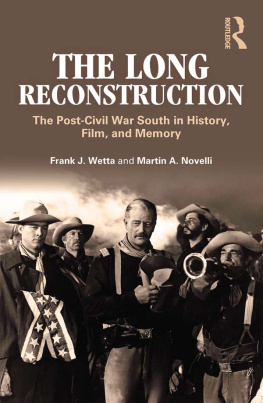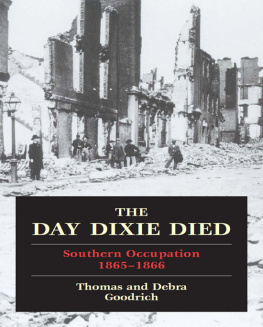The American South Series
Elizabeth R. Varon, Editor
Designing
Dixie
TOURISM, MEMORY,
AND URBAN SPACE IN
THE NEW SOUTH
REIKO HILLYER
University of Virginia Press
Charlottesville and London
2015 by the Rector and Visitors of the University of Virginia
All rights reserved
Printed in the United States of America on acid-free paper
First published 2015
ISBN 978-0-8139-3670-3
1 3 5 7 9 8 6 4 2
Library of Congress Cataloging-in-Publication Data is available from the Library of Congress.
Illustrations
Pierre Havens, Cordova Hotel, c. 1890s
Birds-eye view of Alcazar and Cordova hotels from the Ponce de Leon, St. Augustine, c. 1900
Charles Seaver, view of St. Augustine from the Florida House, n.d.
Florida House, St. Augustine, c. 1870s
Stanley Morrow, Hotel San Marco, c. 188287
Joseph John Kirkbride, Grand Hotel, Catskill Mountains, New York, c. 188491
Ponce de Leon Hotel, St. Augustine, n.d.
Waiters at the Ponce de Leon Hotel
Richmond, Chamber of Commerce building, c. 1910s
Richmond Opportunity, 1915
Hotel Jefferson, c. 1903
William Henry Jackson, rotunda, Jefferson Hotel, c. 1908
Jamestown Tercentennial Exposition, 1907
Kimball House, c. 1870s
W. A. Hemphill residence, Atlanta, 1890
View on Whitehall Street, Atlanta, c. 1895
Candler Building, c. 1910s, Atlanta
English-American Building, Atlanta
Prudential and Equitable buildings, 1907
Acknowledgments
It is difficult to find the words to express the debt that I owe others in the realization of this book. This project began as a doctoral dissertation at Columbia University, where I had the privilege of working with extraordinary teachers and colleagues. Eric Foner indelibly shaped my thinking as a scholar and mentor by challenging me to consider the fluid and fragile nature of human freedom. I thank William Leach for transcending the conventions of academic specialization and for the expansiveness of his imagination. I am grateful to Hillary Ballon and Jeannie Attie for serving on my dissertation committee and offering suggestions on how to strengthen the manuscript for publication.
This project would not have been possible without the help of many generous archivists and librarians. I am indebted to the librarians at the Virginia Historical Society, the Atlanta History Center, the Special Collections at the University of Florida, and the Dibner Library at the Smithsonian Institution. I offer especial thanks for the patience and expertise of Charles Tingley and Robert Nawrocki at the St. Augustine Historical Society. They showed genuine interest in my work and shared the gems of their archives and knowledge. I am also appreciative of the financial support I have received from Columbia University, the Mellon Foundation, and the Baird Foundation at the Smithsonian. Thanks to the Consortium for a Strong Minority Presence at Liberal Arts Colleges, I was lucky enough to be able to work on my dissertation while being nourished by the wonderful students and faculty at Lewis and Clark College and at Colorado College.
I am deeply grateful for those who generously offered comments on earlier iterations of this work in the form of conference papers, in particular, Catherine Cocks. Thank-you to Molly Berger and Leslie Sternlieb for editing my essay, The New South in the Ancient City: Tourism, Flaglers St. Augustine Hotels, and Sectional Reconciliation, for publication in the Journal of Decorative and Propaganda Arts 25. The opportunity to write that article, aided by their supportive counsel, was a crucial step in convincing me that this project was possible. Working on that article also put me in the company of wonderful scholars, including Daniel Levinson Wilk, who was extremely generous in sharing his research on hotels with me.
This project rests on the shoulders of countless others. At Columbia, the dissertation workshop Take Two provided hilarity and intellectual camaraderie. In particular, I would like to thank my dear friends Monica Gisolfi and Jeffrey Trask, who have become my family. Their collaboration, support, editing, humor, perspective, and love have sustained me since the beginning of this journey. During my year at Colorado College, I was unexpectedly blessed with the companionship of James Reid and Rick Furtak. Our conversations and karaoke provided essential nourishment that year. The entire History Department at Lewis and Clark College deserves my gratitude for their unwavering support during some challenging times. I am particularly grateful to Andrew Bernstein, who eased me through difficult transitions. His suggestions on my work were indispensible, and his genius for powerful opening sentences is an inspiration. I am also indebted to my colleagues and friends Dawn Odell and Mo Healy, who read various portions of the manuscript and offered exacting and supportive criticism. Members of the womens history reading group in Portland also commented on sections of this manuscript, and their encouragement and perspective were integral to this project. I am deeply appreciative of anonymous readers at University of Virginia Press whose rigorous and thoughtful comments made this a better book. I extend special gratitude to Dick Holway at the University of Virginia Press for his guidance at every step of the process and for showing such confidence in this project when I needed it most. Robert Burchfield deserves thanks for his careful copyediting. My experiences at the Tepoztln Institute for the Transnational History of the Americas has provided brilliance and burlesque in equal measure. Thank-you to David Menschel, who offered encouragement and insightful commentary since the earliest stages of this work, and helped me learn how to read landscapes. Thank-you to my siblings, Linda and Jonathan, and to my dear friend Eden Wurmfeld for their interest in this project and their investment in its success. I am grateful that my mother, Kazuko, has always given me the freedom to pursue my hearts desire. I thank my father, Raphael, for always asking what books I am reading and then reading those books himself. His unquenchable curiosity has been a model for my own. I thank Yuko Ito for her unconditional love and only wish that my Japanese were good enough to explain this project to her. I thank all of my students, past and present, who nourish me every day.
I could not have completed this project without the love and partnership of Elliott Young. Elliotts activism and intellect have both fed and humbled me in enduring ways. An extraordinary comerade and companion, Elliott has taught me how to cross borders, and has helped me recover both lost files and lost confidence. Elliotts ability to find thirty-five hours in a day and attain excellence in so many things at once is an inspiration. Zulema has grown up alongside this project, and I am full of thanks for her patience. Elliott and Zulema have allowed me to imagine a world beyond this book, and for that I am eternally grateful.
I have saved my greatest debts for last. Elizabeth Blackmar often had a better understanding of, and more faith in, my project than I. She showed me how to interpret the landscape, and, in so doing, helped me find an intellectual home that engages all the parts of who I am. In short, she has taught me how to see. Finally, I cannot thank my dissertation adviser, Barbara J. Fields, enough. Her insistence on and appreciation for elegance and precision in language, her commitment to the humanity of all historical subjects, and her devotion to justice and beauty have forever moved me to be a better writer, historian, and human being. Though I might presume to count Betsy and Barbara among my dearest friends, they will always be my teachers.





